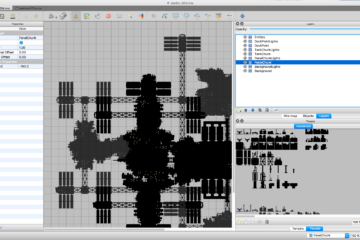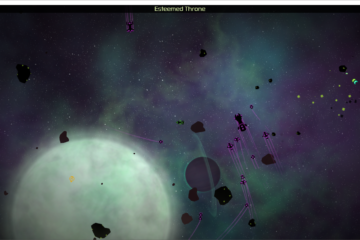It’s been… literal years since I blogged here but I’ve been thinking a lot about how to maintain healthy side projects without burning out. Then a random twitter thread got me thinking that I should write some of these thoughts down.
I have always had some side hustle going. I built a website that managed Magic the Gathering card collections before anything like it existed online. I built an ecommerce website that sold and dropshipped products from China before this was common on Amazon. I host the website for FlatRedBall and regularly contribute to the engine and tooling development process. I built a mediocre JavaScript game engine for fun, then a multiplayer networking engine. I worked on The Incredible Baron and helped port an Xbox360 game called Super Refreshmen to mobile devices. I released Masteroid, KosmoSquad, and am working on WeeRPG. I usually have a lot of GitHub contributions. I participate in regular gamejams and do my best to help young people find success in tech careers. I also like to learn unrelated skills like auto mechanics, welding, and woodworking.
The majority of my career growth has come from connections made and skills learned from my side projects. But I have also burned out spectacularly. So what makes the difference? These observations are as much a letter to myself as it is advice to anyone else…
Know Thy Strengths
First of all, I believe everyone has unique aspects of their personality, life situation, job, and other things that affect how they work and what they can sustain. With this in mind, it’s impossible to create a “formula for not burning out” but it should be possible to come up with a framework to recognize your practical limits. Here are some of my strengths and weaknesses:
- I have a family, including a daughter with special needs.
- My working time can be unpredictable due to family issues or career – I need to be careful not to let my enthusiasm for projects have a negative impact on my family.
- I have a partner who also loves projects and is really supportive of mine.
- I have the means to fund my side projects within reason, and am financially stable in my career.
- I need to sleep about 7 hours per night, eat healthy, and get exercise
- I rarely have to work more than 45 hours in a week and I don’t usually work weekends
- I don’t have a TV. I try to treat entertainment like a healthy diet and make conscious choices about what I put into my brain. This frees up a huge amount of time that would otherwise disappear.
So there are things that must occupy my time for me to be healthy and have healthy relationships. There are other things that can occupy my time but do not add value or enjoyment to my life. There are also strengths or privileges I have that can support my goals. It’s important to know what belongs in your life and what occupies time but doesn’t bring fulfillment. It’s also important to understand your strengths, weaknesses, and be honest about your limits.
With this in mind, I have a rough benchmark for the amount of hours I have to invest in side projects. That number is 40 hours per month, or roughly 10 hours per week. I can usually work two evenings a week and get 2-3 hours of work in each evening. I can also usually find some extra time on Friday night or the weekend. Sometimes I get excited and work extra. Sometimes I am too busy and don’t work. The average is 40.
Attributes of Healthy Side Projects
Here are attributes I’ve identified in my successful side projects:
- Energy – Good side projects generate more energy than they consume.
- Network – Meeting new people and widening your social circle is a good sign.
- Skills – Side projects should not overlap with career work, they should complement it.
- Deliverables/Milestones – Side projects should have regular, tangible outputs. Having something to show off boosts confidence and maintains energy.
- Regularity – Healthy side projects will have regular activity. If it’s not regular, it’s probably not exciting enough to be worth it.
- Relax – Ironically, side projects have helped me be less stressed at points when my life or job was very stressful. You should have control of your side projects and they should give you feelings of confidence, control, and enthusiasm.
- Variety – I like doing the art and development on video games. When my brain is not up for code, I do art. When I’m excited about bringing that art to life, I write code.
- Timeline – Deadlines are bad. Timelines are good. Know how much of yourself you are investing and have a way of measuring your progress.
- Challenge – If it’s not challenging, it’s entertainment. Challenge yourself and learn when you need to push through and when it’s more healthy to throw in the towel. This is the hardest balance to maintain.
The absolute best output of a side project are the skills you learned, the friends you made, and something to show off. But “something to show off” is the least important of these. Do not lose sight of that.
Attributes of Unhealthy Side Projects
Here are attributes I’ve identified that led, sometimes very quickly, to burnout. These are the red flags:
- Stress/Anxiety – It’s okay for a side project to be hard work. Hard work can be fun. But when it’s generating stress or anxiety it rapidly becomes unhealthy.
- Income – If you depend on income from your side project, it’s not a side project it’s a second job.
- Cost – Side projects can have costs but should not endanger your personal finances. The best ones are self-sustaining.
- Sunk Cost – If you ever feel like you are only continuing because of the work you’ve already done, quit ASAP. The completed work was a valuable learning experience, move on.
- Overlap – Side projects that are too similar to your career may end up being a conflict of interest that put you in an awkward position and will definitely burn you out. Side projects should complement existing skills, not overwork them.
- Deadline – Side project deadlines should be non-existent or soft. Timelines are good, deadlines are bad. Know how long you are going to work on something but don’t draw a line
- Conflict – Work with people that bring you joy. And if your side projects are affecting relationships with people you care about, walk away from the project.
- Overwork – Know what you can sustain and don’t cross the line too often. The goal is to have fun and learn with Milestones or Deliverables as a rough measurement of progress. If it feels like crunching or a second job, walk away.
Summary
Remember, side projects should make you feel in control. They should make you feel energetic, enthused and empowered. They might make you feel sore and tired but it should be good sore and good tired. Know the difference. Side projects should enhance your career and open new doors, not cause conflicts. Side projects should help you meet and socialize with new people, not be a barrier to your relationships.
Side projects are not for everyone and are not a “virtuous endeavor” on their own merit. They are only worth the value they add to your life. I personally find satisfaction, energy, and great enjoyment in a steady stream of challenging side projects. If you do too, I hope these observations help you maintain a healthy balance.

